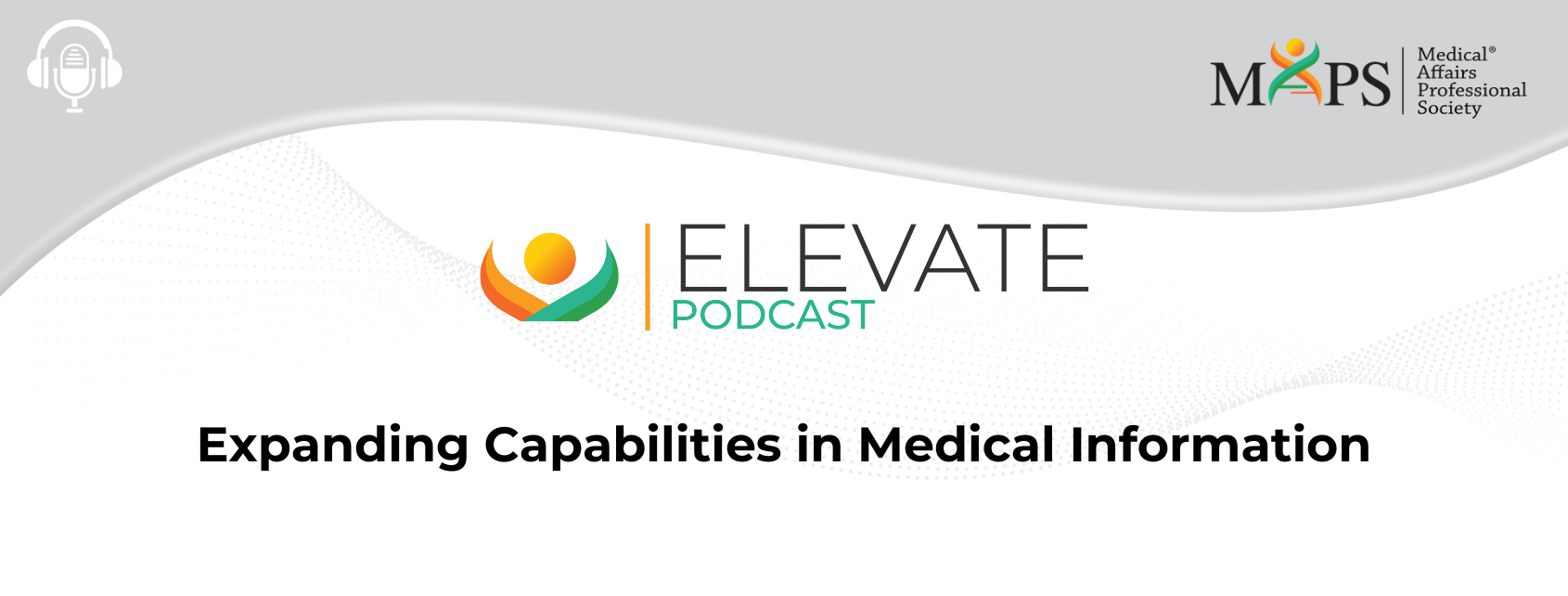Expanding Capabilities in Medical Information
Objectives:
This session will provide: Overview of the Foundation of Medical Information, Enhancement Opportunities for Medical Information, and Medical Information Value to the Organization

SPEAKER: Lisa Khosla

SPEAKER: Urvashi Vashee
Following is an automated transcription provided by otter.ai. Please excuse inaccuracies.
Lisa Khosla
Welcome to the Medical Affairs Professional Society Medical Information Focus Area Working Group’s podcast on “Expanding Capabilities in Medical Information. My name is Lisa and I’ll be one of the two speakers for this podcast. I’m also joined by Urvashi. We currently serve as members of the Medical Information Focus Area Working Group.
The views expressed in this recording are those of the individuals and do not necessarily reflect on the opinions of MAPS or the companies with which they are affiliated. This podcast is for informational purposes only and is not intended as legal or regulatory advice.
We encourage you to engage in conversations about Medical Information with other MAPS members via MAPS Connect on the MAPS website or mobile app. Simply login with the email address and password associated with your MAPS account and access the global community. Then click on the Discuss tab and scroll down to Medical Information to post a question or review previous postings.
The podcast objectives are: to provide an overview of the foundation of Medical Information, to discuss enhancement opportunities for Medical Information, and also to present the Medical Information value to the organization.
Speaking today with me is Urvashi Vashi, who is a PharmD and is the Senior Director of Medical Information at Oncopeptides Inc. And again, my name is Lisa Khosla. I’m a PharmD and MHA and I’m currently the Director of Medical Information at Oncopeptides Inc. A little information about myself just to share is that prior to joining Oncopeptides, I have worked at Merck and AstraZeneca and have over seven years of industry experience. Prior to industry, I was at the FDA for about two years and also at the National Institutes of Health working in the clinical center in oncology. I will turn it over to Urvashi to briefly introduce herself.
Urvashi Vashi
Hi everybody. As Lisa mentioned, I am currently the Senior Director for the Medical Information team at Oncopeptides. I’ve been in the pharmaceutical industry for over 20 years in a variety of roles primarily in Medical Affairs. Also inclusive of medical training and also in my prior life I was an MSL, I’ve worked within government affairs and both in the US as well as the global organizations within the medical pharmaceutical industry. Aside from the industry, I’ve also worked in managed care and also at the FDA in pharmacovigilance. So with that, let’s go ahead and get started and begin our podcast today on the foundation of Medical Information so that we all know what that is, as of today. So Lisa, can you please give me an overview of what the foundations are in today’s typical Medical Information departments?
Lisa Khosla
Yes, definitely. So when we speak about the foundation of Medical Information, we are referring to the traditional roles that Medical Information has within an organization. The Medical Information function is known to have scientific expertise, product knowledge or disease state expertise. And as the frontline for the call center – pretty much the voice to the customers such as you know, physicians and patients – Medical Information also has Regulatory Commission review knowledge and is a source for internal organizational partnerships and serves to triage product quality complaints and adverse events. My team members wear several hats on a daily basis.
Urvashi Vashi
That’s great. Now based on these roles and the expertise that you’ve mentioned, what are the typical and standard deliverables for Medical Information?
Lisa Khosla
Thanks for asking, Urvashi. To put this into perspective, Medical Information standard deliverables include serving as a frontline contact for HCPs and consumers in order to respond to unsolicited requests with scientific response letters, develop frequently asked questions, work on Medicaid, Medicare testimonials summaries, provide scientific commenting and supporting the field medical liaison in many organizations as a standard scope of work. They also provide medical review for promotional and medical materials, and also submit therapeutic area guidelines, and gather or share insights across Medical Affairs.
Urvashi Vashi
I see. That’s great and sounds like these deliverables are imperative to the success of the organization. In order to provide these deliverables, what sort of capabilities need to be in place successfully in the Medical Information departments?
Lisa Khosla
To have success in my function, one should have definitely extensive therapeutic area and product expertise. We need to also be an integral member of the medical team providing communication and collaboration across the functions, and also have Regulatory and Medical Affairs process expertise because it’s pretty heavy on the process and to know and understand that that process is key. And to be able to provide content metrics and optimization to address any gaps that come up. In summary, my team has proven results time and time again, but can only do so with a highly skilled team that delivers strategically aligned high quality content, with quicker turnaround times.
Urvashi Vashi
Thank you for providing that, Lisa. That’s great. Let’s move on to speaking more about expanding the capabilities and the opportunities for Medical Information, which really is the focus of our podcast today. In order to talk about the expansion, we first need to take a look at the collaboration and the partnerships that MI has within any organization. Lisa, it would be great if you could please review some of those key partnerships that MI has, and how those partnerships influence or affect the organizational or Medical Affairs strategy for Medical Information.
Lisa Khosla
Of course! So some of the partnerships include promotional, Regulatory Affairs, our partnerships with corporate communications with vendors or agencies, or local MI teams, Medical Affairs, commercial and marketing, definitely, and, also, market access, just to name a few. These partnerships are so important because they support cross functional alignment, which in turn influences the strategic and tactical deliverables of Medical Information, and essentially for Medical Affairs. Overall, the biggest partnership that influences the strategic plan is with our Medical Affairs function. The Medical Affairs strategic plan has components that affect the Medical Information strategic plan, the overlap of the combined strategy brings a direct alignment with the organization deliverables as a whole.
Urvashi Vashi
That’s great, Lisa, Thank you. Now that we’ve reviewed some of the current ways of working in Medical Information, perhaps you can tell us a little bit more about how the Medical Information opportunities come about when you work within the global as well as the US market? For example, which is considered a local market, which may be similar in some ways, but can be quite different in others?
Lisa Khosla
That’s a great question Urvashi. And I’m glad you asked, because a lot of times, folks do have that question as far as global versus US or local market, so when it comes to development, maintenance and plan for content, the markets and global are quite similar. For example, just to name a few, the review and approval process requires a review or approval within a system of record, that’s going to be the same globally in all markets, the asset storage used would be the same platform. Such as Veeva Vaults, we use that a lot. It could be other types of platforms. This helps with version control in one place for access. The types of assets created would be similar to global and medical, such as medical FAQs, maybe some slides, except that assets created globally would be localized by the US and other local markets, for specific local market needs. Those would be developed by the local market themselves; in this case, the US. Also strategic planning for the brand or disease state would be aligned and filtered down from global to US. With cross collaboration from different functions, the assets creation and update would be similar as well. And it provides an opportunity to collaborate within MI globally and within the US and my team in the local market teams. Pretty much the US and my assets and other local markets undergo continuous maintenance throughout the year. You can see further details on slides 13 and 14 in our attach presentation with this podcast for further details on this. Now you mentioned global and US alignment when it comes to strategic planning. Now what about alignment specifically with the Medical Affairs strategy? Its Medical Information works so closely with Medical Affairs.
Urvashi Vashi
Yeah, that’s a great point. So when it comes to alignment, Medical Information focuses on the parties based off the MA or the Medical Affairs strategic goals. Now those goals as we previously mentioned, feeds into other MI priorities and deliverables. So MI really hones in and focuses primarily on advancing the scientific content prioritizing relevant MI content that can be done differently within different organizations. And this can present an opportunity to expand Medical Information capabilities within the industry that could be on developing content such as backgrounders or infographics which are done in some organizations, but it’s not widespread. Sharing customer insights is a tremendous opportunity for Medical Information, as oftentimes it’s a forgotten tidbit of information that is very valuable for the organization. What Medical Information can do is provide insight trend analysis, and additional assessments to further inform the strategy and also more importantly, address any gaps which could then be leveraged into publications and into different types of activities. And then also building the MI community is a critical pillar and potential opportunity, improving the capabilities the global MI capabilities with systems improvements, increasing the visibility of the MI team, not just within one market but across the globe will then build that continual presence like you see within other organizations and Medical Affairs. It’s also important just to mention that there are also drivers for change Medical Information both internally and externally, which will influence the ability of the departments to progress and continue to expand their offerings and their capabilities. This can include but is not limited to the increased complexity of the information that we have today, the data, physicians time is also constrained. So providing that information at a much more consolidated, streamlined manner is an ongoing challenge, but also presents an opportunity for MI. And then shifting potentially to digital content and resources that we need to manage the growing body of work is also again a potential challenge, but it can be an opportunity, because it allows us to maybe look at delivering content in a very different way. So Lisa, let’s just switch gears a little bit now that we’ve discussed expanding the opportunities in Medical Information to potential future challenges in which MI can help enhance the customer experience and further partner cross functionally, to get our job done. Okay, so Lisa, let’s switch gears now that we’ve discussed expanding the opportunities in Medical Information to the future challenges in which MI can help enhance the customer experience and further partner cross functionally.
Lisa Khosla
Thanks, Urvashi. Some of the future opportunities MI has definitely we’ve gone over some things but MI should continue supporting the enhanced customer experience and outcomes. It should increase the two-way link between external and internal stakeholders globally to provide accurate and up to date information. I think MI also has the opportunity to enhance the medical partnership to improve the customer experiences with MI services, and also to improve the commercial marketing partnerships, which is so important to ensure business continuity and consistency as appropriate. There are specific opportunities for MI role expansion as a major partner as well, which includes our participation, health economics and payer teams, the knowledge in that area, implementation of digital capabilities for asset developments such as podcasts – such as this one that we’re doing – the virtual booth staffing. Definitely with the pandemic going on, everyone was forced to go virtual. So managing through that change was definitely something that Medical Information had to figure out. And I think that was a great opportunity for us to expand in that role to support the congresses virtually. nAnd then also the ad hoc advisory board support. Many times Medical Information is called upon to support certain content for ad hoc advisory boards. So I think further expanding on that opportunity is great.
Urvashi Vashi
Thank you, Lisa. So in summary, I think the future of Medical Information is bright. And I think we can continue to serve as an integral member of the Medical Affairs organization, provide unsolicited product or disease state information to healthcare professionals to ensure they have the most relevant information to make an informed decision. But to do so, in various ways, expanding the opportunities that we have in front of us to take advantage of things like artificial intelligence in the future is potentially something that the medical and Medical Information teams can look at developing content outside of just the standard responses and the frequently asked questions cross my mind. Well, we know that happens within some parts of the organizations and the business, it doesn’t happen more widespread and consistently, maybe looking again, a proactive compendium planning and submissions. The virtual congress planning and attendance, which I anticipate will continue even as the pandemic subsides, and then also having a greater involvement in the development of the Medical Affairs strategy and in particular, Medical Information, strategic imperatives and how those really roll into the wider Medical Affairs strategy.
We really want to thank all of you for your time and attention today. We would like to thank you for joining us in this podcast and also your support for MAPS. If you’re not yet a MAPS member and would like to access would like access to additional resources in this area, please visit the MAPS website to explore joining today at: medicalaffairs.org/ membership. This concludes our podcast today.



